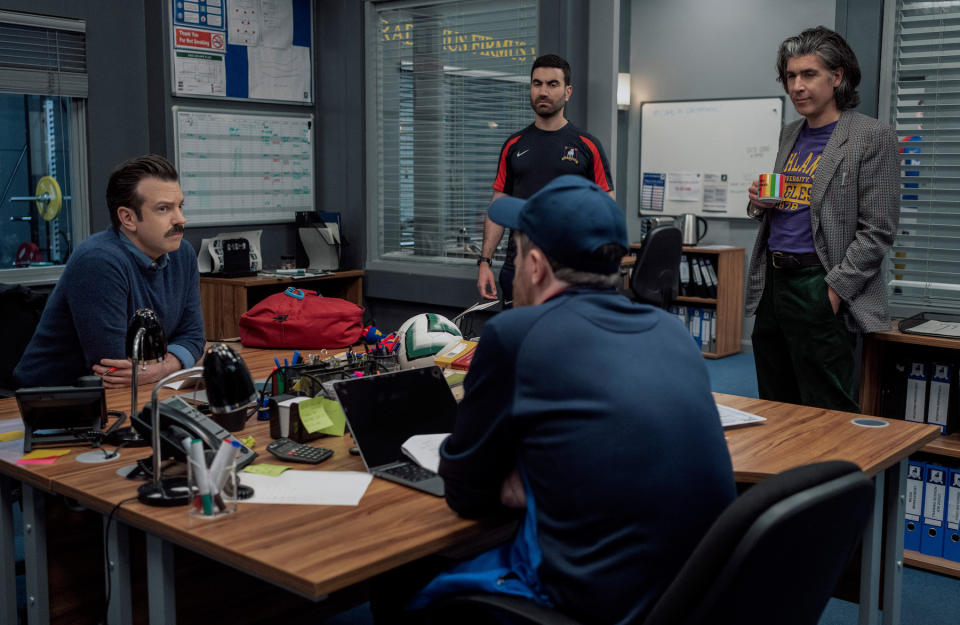‘Ted Lasso’ Is a Mess This Season. What Happened?

- Oops!Something went wrong.Please try again later.
One of the best moments of “Ted Lasso” Season 3 came in this week’s “La Locker Room Aux Folles” and if you looked away for 10 seconds you’d have missed it. During halftime of a Premier League match, right after Isaac (Kola Bokinni) has gone into the stands to fight a homophobic AFC Richmond supporter, the captain hands his band to Sam (Toheeb Jimoh) to take his spot in his absence. Puncturing the seriousness, Jamie (Phil Dunster) and Sam have a playful back-and-forth about who should have it. Jamie playfully gestures to send the armband his way. Sam flips him off with a smile.
It’s a reminder of what “Ted Lasso” hasn’t been in recent weeks. Season 3 has largely become a bundle of ideas and thought exercises cobbled together in place of having any bigger plan. There was a throughline in the show’s opening season about gaining trust and the limits of performative optimism. It wasn’t hard to read Season 2’s messiness as a metaphor for living up to lofty expectations. By comparison, these past few weeks have seen the show set out a handful of character endgames and fill in the rest with unloading the draft folders. (Pop-up books! Snow globes! Bob Marley songs! Shandy!!)
More from IndieWire
'Ted Lasso' Dedicated an Episode to a Journalist Who Helped the Show Solve Trent Crimm
'Schmigadoon!' Season 2 Is Perfect for Anyone Who Thought the First Season Wasn't for Them
The brewing idea in Season 3 is Ted’s (Jason Sudeikis) implementation of the Total Football strategy, one where players’ set positions are all flexible for the needs of the team’s offense. In reality, Season 3 has also done that for its cast, putting them all into a giant plot casserole where the individual ingredients have gotten lost in the overall mix. So not only does it feel odd that there’s a redemptive meet-cute arc with a thinly-drawn girlfriend character, it feels doubly weird to have it centered around Nate, who was set up to be the villain character this season. Watching it, it just seems like the “Ted Lasso” surprise romance lever needed to be pulled, and the recipient matters all that much. The show’s previously distinct characters are a lot closer to interchangeable cogs now, something that’s become even more noticeable as they’ve flung out into their own separate stories.
It’s all in service of trying to give a shake-up to a series that needs one, even if the versions it’s getting have felt half-hearted. “Ted Lasso” arrived at its core “Believe” destination so long ago that the show has had to come up with arbitrary obstacles to force all its characters to keep buying into the goofy-hearted coach at its core. Egocentric superstars coming in to test the team dynamic and Ted’s coaching abilities? Zava became a bewildering, water-treading sequel to Jamie’s comeback, despite casting someone who would have brought more to that subplot if given the chance. The concept of taking the squad on a group trip to help them unlock a better sense of teamwork? Repeated this season, with Episode 6’s Amsterdam trip a muddled version of the much-more-efficient sewer trip just a few weeks prior.
All of this is at least a little retroactively damning of the show’s first two seasons, which had ample time to build these players into more than a single catchphrase or a shared name with an ’80s action star. It’s the reason that last week’s discussion of revenge porn and Colin’s (Billy Harris) coming-out story feel spread so thin: all of those sentiments are delivered by characters who’ve become more or less interchangeable. The show’s success brought it to a point where there are so many different on-screen personalities they’re trying to serve, that if someone pops up now it’s only for a specific purpose. (Trent Crimm getting half-heartedly roped into the Diamond Dogs is maybe the purest sign that recreating the old magic and finding new sparks have both been failing efforts.)

A significant exception is Sam. Yet even he, aside from that Captain band moment and last week’s episode with his father, has been effectively relegated to the sidelines. He’s been caught in the general “Ted Lasso” inability to juggle multiple ideas at once. Characters who the show has been able to check in with more regularly now only exist to deliver their Big Idea – Rebecca and motherhood, Keeley and companionship, Nate and overcoming self-sabotage. It also makes the significant time investment spent in characters like Zava or Keeley’s old friend Shandy — designed to be introduced, thinly developed, and discarded in short order — feel all the more frustrating. The efficiency of “Ted Lasso” used to lie in using moments as a prism for multiple people (part of what makes that Season 1 dart scene so fun is what it says about Ted, Rebecca, and Rupert all at the same time). Wrangling those same characters into situations that can only address one of them at a time has only added to the Season 3 sluggishness — and adds to the way-too-long runtimes of most episodes.
Another result is episodes that feel self-contained to a fault, existing in their own thematic silos before the show hits reset. Where the show used to use those standout episodes to advance things overall, now it feels like the show is just trying to get back to Season 1, not just in its joke style (Beard’s shouting match with reporters would have worked at least a little bit better in the context of a show that was using a post-match press conference for something other than a random conflict to kill time) but in everyone having relatively clean slates to project problems and solutions onto. Even using the Beatles in last week’s episode felt less like a legitimate moment with Ted’s son and more a chance to earn some goodwill by aligning the show with the most stereotypically British, universally liked thing it could muster.
One of the biggest complaints levied against last season’s Beard-centric episode is that it provided answers to questions that no one was asking. The thinking went that “Ted Lasso” and Brendan Hunt had done such a good job of shading the character around the edges that devoting an entire chapter to his off time seemed repetitive at best and deflating at worst. The latest Colin arc is almost the show encountering that problem in reverse. Harris is bringing as much sensitivity to Colin’s story as the show has given him room for, but backfilling his story with this single part of his identity feels like the show making up for lost time.
Maybe the most telling choice in “La Locker Room Aux Folles” is that it sets up Colin as the hero of the match without giving him those on-pitch moments to shine. Is that a sign that in this stage of the story, the soccer stuff is just a means to an end? Is it an effort to turn in episodes of the show that aren’t dancing dangerously close to an hour? Is it the sign of a show that ditched a rhythm that worked and is now struggling in getting back to basics? Whatever the reason, it boosts the idea that the show’s final episodes have largely become a building of ideas without a foundation, one that only stays standing as long as you don’t think about it.
None of these problems are unique to a workplace comedy, which “Ted Lasso” did best at the height of its creative success and popularity. (Even “Cheers” had to make a decision whether or not to leave the bar after its debut season.) Despite all of these Season 3 missteps, the pieces are in place for a reunion closer to the finale that gives one more big chance for everyone to bounce off each other in the ways they all used to. But it sure feels like it’s gotten to the point where continuing on past that would just invite more redundancies and retcons and filler. However clumsy the execution and however little there is backing them up, “Ted Lasso” is tossing a lot of ideas into the mix. Maybe now is the time for those ideas to scatter and find homes with teams better suited to make them mean something more.
New episodes of “Ted Lasso” Season 3 are available Wednesdays on Apple TV+.
Best of IndieWire
Sign up for Indiewire's Newsletter. For the latest news, follow us on Facebook, Twitter, and Instagram.

